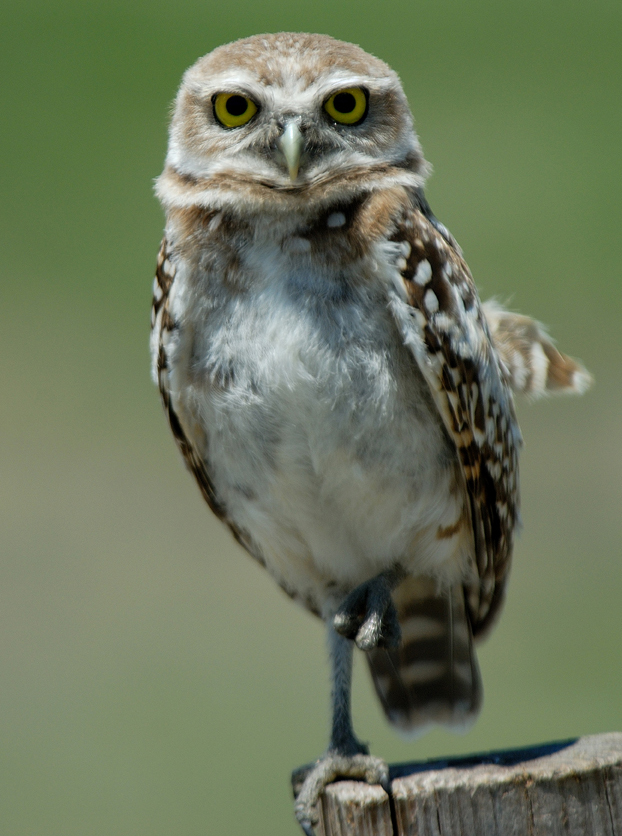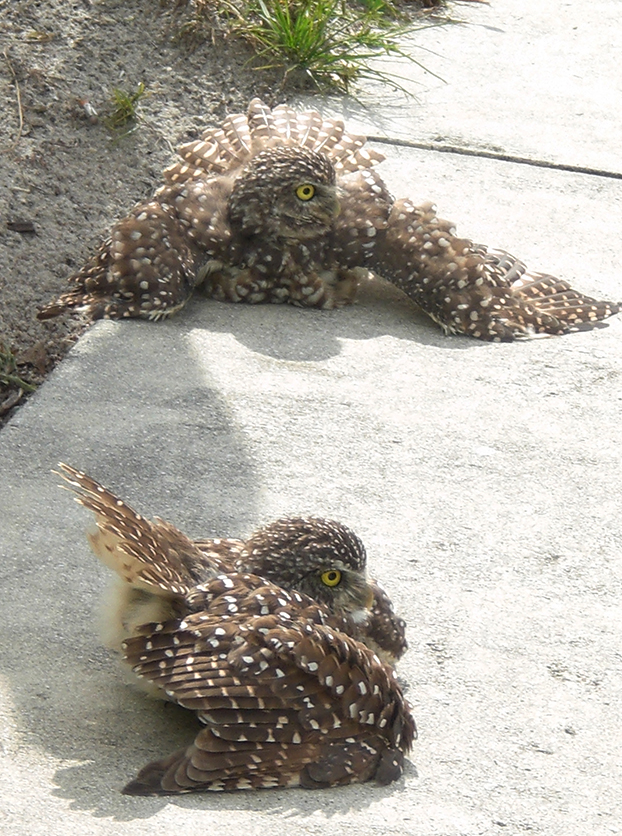Is the Burrowing Owl in immediate danger, for example vandalism or construction activity?
Contact the Law Enforcement Division of the Florida Fish and Wildlife Conservation Commission.
myfwc.com
1-888-404-FWCC(3922)
Cell phones call *FWC or #FWC
You can call 24 hours a day/7 days a week and can choose to remain anonymous. If the owls are not in immediate danger, the FWC can send signs to the property owner or manager for use in notifying people in the area of the protected status of the Burrowing Owls.
Do the owls need protecting or is there a new unmarked nests?
Please send a good description of the location, address, GPS point, and a picture always helps.
Broward, Miami Dade, and Palm Beach Counties:
Contact via email at owl@projectperch.org.
Lee County:
Contact Cape Coral Friends of Wildlife at 239-980-2593
https://ccfriendsofwildlife.org/resources/contact/
GUIDE TO INJURED BURROWING OWLS
WHEN DO THEY NEED HELP?
A Protected Species
Florida Burrowing owls are a State listed as “Threatened Species”. This means that the birds, their eggs and burrows are protected by Federal and State laws. Although you are trying to help them, you cannot disturb, pursue, hunt, or catch a Burrowing owl; it is against the law.
On top of that, a sick or injured owl is already stressed out. The owl can be weak and dehydrated. You do not want to add to its distress. You always want to observe the owl from a safe distance, use binoculars if you can.
Your ONLY job is to be a trained observer. You want to ask and answer all of the questions and then call for the right help, if it is necessary.
Are you sure it is a Burrowing owl?
FLORIDA’S BURROWING OWLS
Is the owl small, about 9” tall?
Does it LACK ear tufts?
Does it have a round head?
Is it dirt brown with white spots?
Or is it buff colored?
Does it have long legs?
EASTERN SCREECH OWLS
Does it HAVE ear tufts?
Is the owl gray or red in color?
Is the underside strongly barred?
Does it have short legs?
Eastern Screech owls typically nest in tree cavities while Burrowing owls usually nest underground. Sometimes habitat can be an indicator, but Burrowing owls do roost in trees.
Are they Owlets?
Owl babies are called owlets and are small, fluffy and buff colored in both species. It makes them difficult to tell apart. Most of the time, the best way to identify a baby is to identify a parent.
Is the owl standing on one leg and so it appears injured?
Birds, including owls, often rest with one leg tucked up underneath them. Sometimes, they may appear like they have a hurt leg, but this is not the case, they are just fine.
Do you think the owl is sick because you have found it during the day?
Most owls are nocturnal or active at night, however; Burrowing owls are diurnal or also active during the day. So it is not unusual to see a Burrowing owl resting or roosting during the day, in fact this is very normal.
Is the Burrowing owl dead?
Burrowing owls are a protected species and are not to be harmed in any way, so help protect them by reporting any dead owls to the proper authorities.
Does the owl have its wing stretched out and so it appears injured?
Burrowing owls enjoy the sunshine and when relaxed, will stretch their wings out and lay very still, often times they are asleep. When they do this on a sidewalk, it appears they have been stepped on.
Does the owl exhibit any of the following indicators?
Does the owl have a visible injury?
Does the owl have uneven shoulders?
Does the owl have a drooping wing?
Does the owl have dilated pupils?
Does the owl wobble or fall over?
Does the owl have tremors or shake?
If you see any of the above indicators, please call and get the owl help. Contact the rescue center closest to the owl’s location.
WILDLIFE CARE CENTERS
East Coast Florida
Broward County:
South Florida Wildlife Center
1-800-SOS-WILD
954-524-4302
Ft Lauderdale, Florida 33315
southfloridawildli
Sawgrass Nature Center
954-752-9453
3000 Sportsplex Dr, Coral Springs, FL 33065
sawgrassnaturecenter.o
Miami Dade County:
Pelican Harbor Seabird Station
305-751-9840
1279 79th Street Causeway
Miami, Florida 33138
pelicanharbor.org/
Wildlife Rescue of Dade County
305-342-1075
dadewildliferescue.com/
Palm Beach County:
McCarthy’s Wildlife Rescue
561-790-2116
12943 61st St N, West Palm Beach, FL 33412
mccarthyswildlife.
Busch Wildlife Sanctuary
561-575-3399
17855 Rocky Pines Rd, Jupiter, FL 33478
buschwildlife.org/
Monroe County:
Marathon Wild Bird Center
305-743-8382
5550 Overseas Hwy A, Marathon, FL 33050
marathonwildbirdcenter.
Key West Wild Bird Center
305-292-1008
1801 White St, Key West, FL 33040
keywestwildlifecenter.
West Coast Florida
Lee County:
CROW Clinic
239-472-3644
3883 Sanibel Captiva Rd, Sanibel, FL 33957
https://crowclinic.org/
We thank you for helping the Burrowing Owls.
Can’t find your location listed?
Reach out to local nature centers, or wildlife organizations.
They may be able to provide guidance on who to contact for assistance.
How to tell if it is a burrowing owl or a screech owl
FLORIDA BURROWING OWL
- 7.5 – 10 inches tall – a short, stocky bird
- Long bare legs
- Smooth rounded head, NO ear tufts
- Big yellow eyes, sometimes green or flecked with black
- Brown birds mottled with white spots on the upper parts
- Spotted breast grading to stripes across the belly
- Bold white unibrow and white chinstrap
- Live in open habitats with sparse vegetation
- Spend most of their time on the ground or on low perches
- Active during the day also dusk and dawn
- Nests and lives underground in burrows they dig themselves
- They will roost in trees during rainy season
EASTERN SCREECH OWL
- 6 – 10 inches tall – a short, stocky bird
- Short feathered legs
- Rounded head with feathered “ear tufts”
- Big yellow-green eyes
- Gray or mostly reddish-brown (rufous) patterned feathers
- Very well camouflaged in the trees, they match bark patterns
- Live in most types of woods (urban or rural)
- Spend most of the time camouflaged in the trees
- Active at night, also dusk and dawn
- Nests and lives in tree cavities excavated by others






